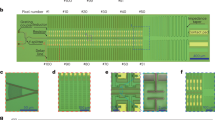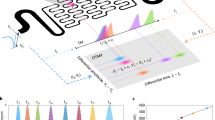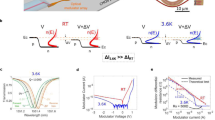Abstract
Coincidence detection of single photons is crucial in numerous quantum technologies and usually requires multiple time-resolved single-photon detectors. However, the electronic readout becomes a major challenge when the measurement basis scales to large numbers of spatial modes. Here, we address this problem by introducing a two-terminal coincidence detector that enables scalable readout of an array of detector segments based on superconducting nanowire microstrip transmission line. Exploiting timing logic, we demonstrate a sixteen-element detector that resolves all 136 possible single-photon and two-photon coincidence events. We further explore the pulse shapes of the detector output and resolve up to four-photon events in a four-element device, giving the detector photon-number-resolving capability. This new detector architecture and operating scheme will be particularly useful for multi-photon coincidence detection in large-scale photonic integrated circuits.
This is a preview of subscription content, access via your institution
Access options
Access Nature and 54 other Nature Portfolio journals
Get Nature+, our best-value online-access subscription
$29.99 / 30 days
cancel any time
Subscribe to this journal
Receive 12 print issues and online access
$259.00 per year
only $21.58 per issue
Buy this article
- Purchase on Springer Link
- Instant access to full article PDF
Prices may be subject to local taxes which are calculated during checkout



Similar content being viewed by others
References
Monroe, C. & Kim, J. Scaling the ion trap quantum processor. Science 339, 1164–1169 (2013).
Childress, L., Walsworth, R. & Lukin, M. Atom-like crystal defects: from quantum computers to biological sensors. Phys. Today 67, 38–43 (2014).
Pant, M., Choi, H., Guha, S. & Englund, D. Percolation based architecture for cluster state quantum computation using photon-mediated entanglement between atomic memories. Preprint at https://arxiv.org/abs/1704.07292 (2017).
Nemoto, K. et al. Photonic architecture for scalable quantum information processing in diamond. Phys. Rev. X 4, 031022 (2014).
Peruzzo, A. et al. Quantum walks of correlated photons. Science 329, 1500–1503 (2010).
Spring, J. B. et al. Boson sampling on a photonic chip. Science 339, 798–801 (2013).
Broome, M. A. et al. Photonic boson sampling in a tunable circuit. Science 339, 794–798 (2013).
Tillmann, M. et al. Experimental boson sampling. Nat. Photon. 7, 540–544 (2013).
Aspuru-Guzik, A. & Walther, P. Photonic quantum simulators. Nat. Phys. 8, 285–291 (2012).
Kok, P. et al. Linear optical quantum computing with photonic qubits. Rev. Mod. Phys. 79, 135 (2007).
Hadfield, R. Single-photon detectors for optical quantum information applications. Nat. Photon. 3, 696–705 (2009).
Natarajan, C. M., Tanner, M. G. & Hadfield, R. H. Superconducting nanowire single-photon detectors: physics and applications. Supercond. Sci. Technol. 25, 063001 (2012).
Marsili, F. et al. Detecting single infrared photons with 93% system efficiency. Nat. Photon. 7, 210–214 (2013).
Najafi, F. et al. Fabrication process yielding saturated nanowire single-photon detectors with 24-ps jitter. IEEE J. Sel. Top. Quantum Electron. 21, 3800507 (2015).
Marsili, F. et al. Efficient single photon detection from 500 nm to 5 μm wavelength. Nano Lett. 12, 4799–4804 (2012).
Shibata, H., Shimizu, K., Takesue, H. & Tokura, Y. Ultimate low system dark-count rate for superconducting nanowire single-photon detector. Opt. Lett. 40, 3428–3431 (2015).
Sprengers, J. P. et al. Waveguide superconducting single-photon detectors for integrated quantum photonic circuits. Appl. Phys. Lett. 99, 181110 (2011).
Pernice, W. et al. High-speed and high-efficiency travelling wave single-photon detectors embedded in nanophotonic circuits. Nat. Commun. 3, 1325 (2012).
Reithmaier, G. et al. On-chip generation, routing, and detection of resonance fluorescence. Nano Lett. 15, 5208–5213 (2015).
Schuck, C., Pernice, W. H. P. & Tang, H. X. NbTiN superconducting nanowire detectors for visible and telecom wavelengths single photon counting on Si3N4 photonic circuits. Appl. Phys. Lett. 102, 051101 (2013).
Najafi, F. et al. On-chip detection of non-classical light by scalable integration of single-photon detectors. Nat. Commun. 6, 5873 (2015).
Rath, P. et al. Superconducting single photon detectors integrated with diamond nanophotonic circuits. Light Sci. Appl. 4, e338 (2015).
Vetter, A. et al. Cavity-enhanced and ultrafast superconducting single-photon detectors. Nano Lett. 16, 7085–7092 (2016).
Shaw, M. et al. Arrays of WSi superconducting nanowire single photon detectors for deep space optical communications. In Conference on Lasers and Electro-Optics JTh2A.68 (2015).
Dauler, E. A. et al. Photon-number-resolution with sub-30-ps timing using multi-element superconducting nanowire single photon detectors. J. Mod. Opt. 56, 364–373 (2009).
Miki, S. et al. Superconducting single photon detectors integrated with single flux quantum readout circuits in a cryocooler. Appl. Phys. Lett. 99, 111108 (2011).
Allman, M. S. et al. A near-infrared 64-pixel superconducting nanowire single photon detector array with integrated multiplexed readout. Appl. Phys. Lett. 106, 192601 (2015).
Doerner, S., Kuzmin, A., Wuensch, S., Charaev, I. & Siegel, M. Operation of multipixel radio-frequency superconducting nanowire single-photon detector arrays. IEEE Trans. Appl. Supercond. 27, 2201005 (2017).
Doerner, S. et al. Frequency-multiplexed bias and readout of a 16-pixel superconducting nanowire single-photon detector array. Appl. Phys. Lett. 111, 032603 (2017).
Hofherr, M. et al. Time-tagged multiplexing of serially biased superconducting nanowire single-photon detectors. IEEE Trans. Appl. Supercond. 23, 2501205 (2013).
Zhao, Q.-Y. et al. Single-photon imager based on a superconducting nanowire delay line. Nat. Photon. 11, 247–251 (2017).
Divochiy, A. et al. Superconducting nanowire photon-number-resolving detector at telecommunication wavelengths. Nat. Photon. 2, 302–306 (2008).
Zhao, Q. et al. Superconducting-nanowire single-photon-detector linear array. Appl. Phys. Lett. 103, 142602 (2013).
Zhu, D et al. Superconducting nanowire single-photon detector on aluminum nitride. In Conference on Lasers and Electro-Optics FTu4C.1 (2016).
Ejrnaes, M., Cristiano, R., Quaranta, O., Pagano, S. & Gaggero, A. A cascade switching superconducting single photon detector. Appl. Phys. Lett. 91, 262509 (2007).
Calandri, N., Zhao, Q.-Y., Zhu, D., Dane, A. & Berggren, K. K. Superconducting nanowire detector jitter limited by detector geometry. Appl. Phys. Lett. 109, 152601 (2016).
Pippard, A. B. The surface impedance of superconductors and normal metals at high frequencies III. The relation between impedance and superconducting penetration depth. Proc. R. Soc. Lond. A 191, 399 (1947).
Mason, P. V. & Gould, R. W. Slow-wave structures utilizing superconducting thin-film transmission lines. J. Appl. Phys. 40, 2039–2051 (1969).
Swihart, J. C. Field solution for a thin-film superconducting strip transmission Line. J. Appl. Phys. 32, 461–469 (1961).
Chang, W. H. The inductance of a superconducting strip transmission line. J. Appl. Phys. 50, 8129–8134 (1979).
Sidorova, M. et al. Physical mechanisms of timing jitter in photon detection by current-carrying superconducting nanowires. Phys. Rev. B 96, 184504 (2017).
Zhao, Q. et al. Intrinsic timing jitter of superconducting nanowire single-photon detectors. Appl. Phys. B 104, 673–678 (2011).
Becker, W. Advanced Time-Correlated Single Photon Counting Techniques (Springer-Verlag, Heidelberg, 2005).
Hu, X., Holzwarth, C. W., Masciarelli, D., Dauler, E. A. & Berggren, K. K. Efficiently coupling light to superconducting nanowire single-photon detectors. IEEE Trans. Appl. Supercond. 19, 336–340 (2009).
Rosfjord, K. M. et al. Nanowire single-photon detector with an integrated optical cavity and anti-reflection coating. Opt. Express 14, 527 (2006).
Kerman, A. J. et al. Kinetic-inductance-limited reset time of superconducting nanowire photon counters. Appl. Phys. Lett. 88, 111116 (2006).
Acknowledgements
We thank J. Daley and M. Mondol for technical support in nanofabrication; C. Chen and F. F. C. Wong for use of their electro-optic modulator; E. Toomey, B. Butters, C.-S. Kim and the QNN-SNSPD team for discussion and assistance. This research was supported by the Air Force Office of Scientific Research grant under contract number FA9550-14-1-0052; National Science Foundation grant under contract number ECCS-1509486; and the DARPA Detect programme through the Army Research Office under cooperative agreement number W911NF-16-2-0192. D.Z. was supported by a National Science Scholarship from A*STAR, Singapore. H.C. was supported in part by a Samsung Scholarship. T.-J.L. was supported by the Department of Defense National Defense Science and Engineering Graduate Fellowship. A.E.D. was supported by a National Aeronautics and Space Administration Space Technology Research Fellowship (award number NNX14AL48H).
Author information
Authors and Affiliations
Contributions
D.Z., Q.-Y.Z., K.K.B. and D.E. conceived and designed the experiment. D.Z. designed the device. D.Z. and T.-J.L. fabricated the device. D.Z., Q.-Y.Z. and H.C. performed the measurement. D.Z. and A.E.D. deposited the superconducting film. K.K.B. and D.E. supervised the project. All authors discussed the results and contributed to writing the paper.
Corresponding authors
Ethics declarations
Competing interests
A related patent (WO2017136585A1) was filed by Q.-Y.Z. and K.K.B. through MIT.
Additional information
Publisher’s note: Springer Nature remains neutral with regard to jurisdictional claims in published maps and institutional affiliations.
Supplementary information
Supplementary Information
Supplementary Text, Supplementary Figures 1–13
Rights and permissions
About this article
Cite this article
Zhu, D., Zhao, QY., Choi, H. et al. A scalable multi-photon coincidence detector based on superconducting nanowires. Nature Nanotech 13, 596–601 (2018). https://doi.org/10.1038/s41565-018-0160-9
Received:
Accepted:
Published:
Issue Date:
DOI: https://doi.org/10.1038/s41565-018-0160-9
This article is cited by
-
Integrated photonic platforms for quantum technology: a review
ISSS Journal of Micro and Smart Systems (2023)
-
Emerging material platforms for integrated microcavity photonics
Science China Physics, Mechanics & Astronomy (2022)
-
Quantum-dot-based deterministic photon–emitter interfaces for scalable photonic quantum technology
Nature Nanotechnology (2021)
-
Linear optical deterministic and reconfigurable SWAP gate
Quantum Information Processing (2021)
-
Broadband on-chip single-photon spectrometer
Nature Communications (2019)



